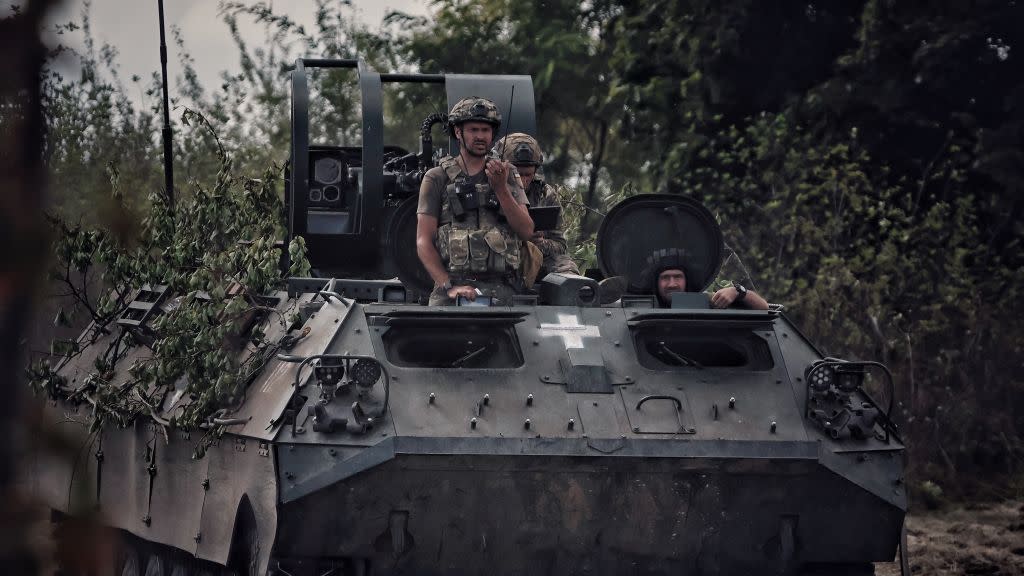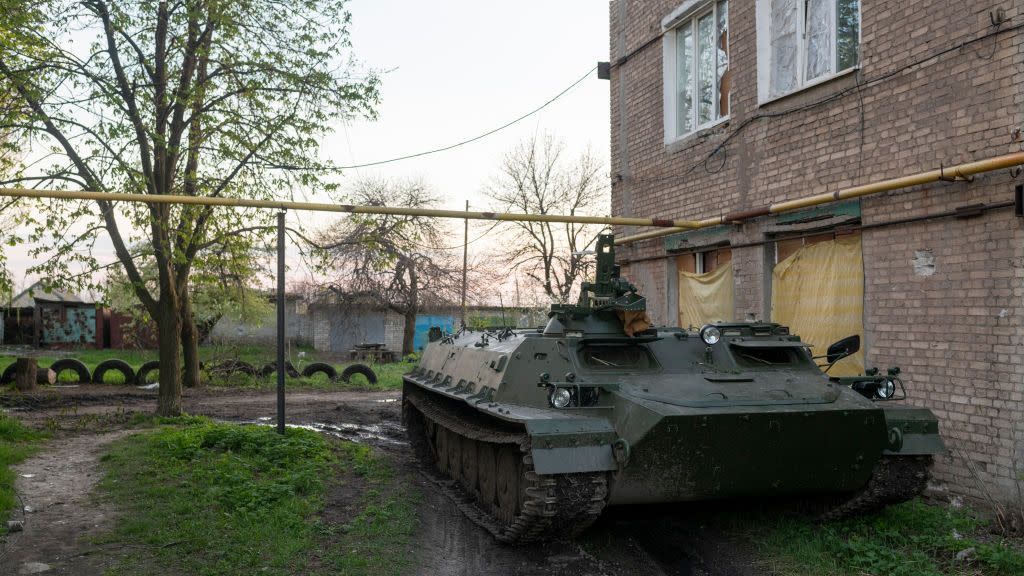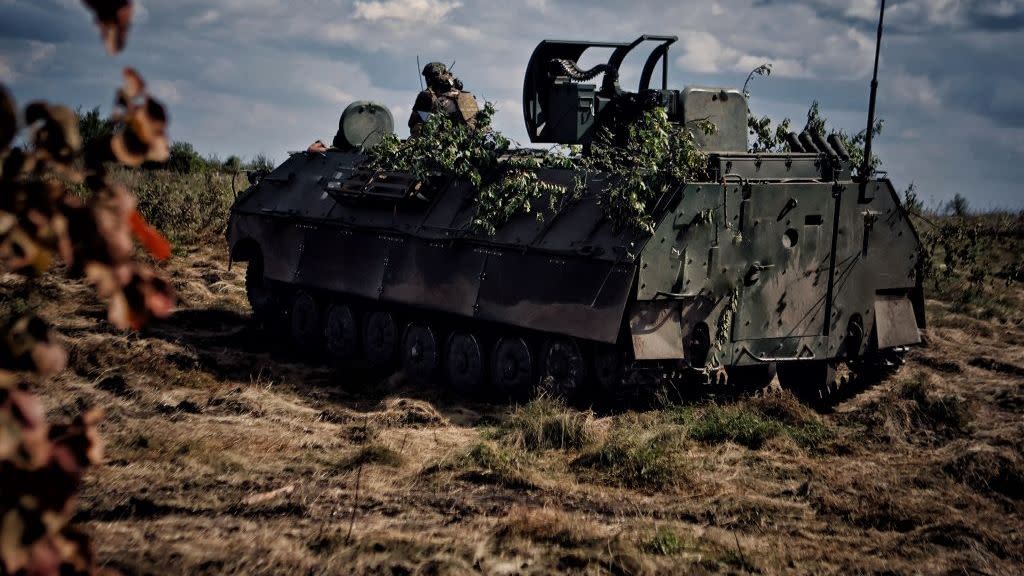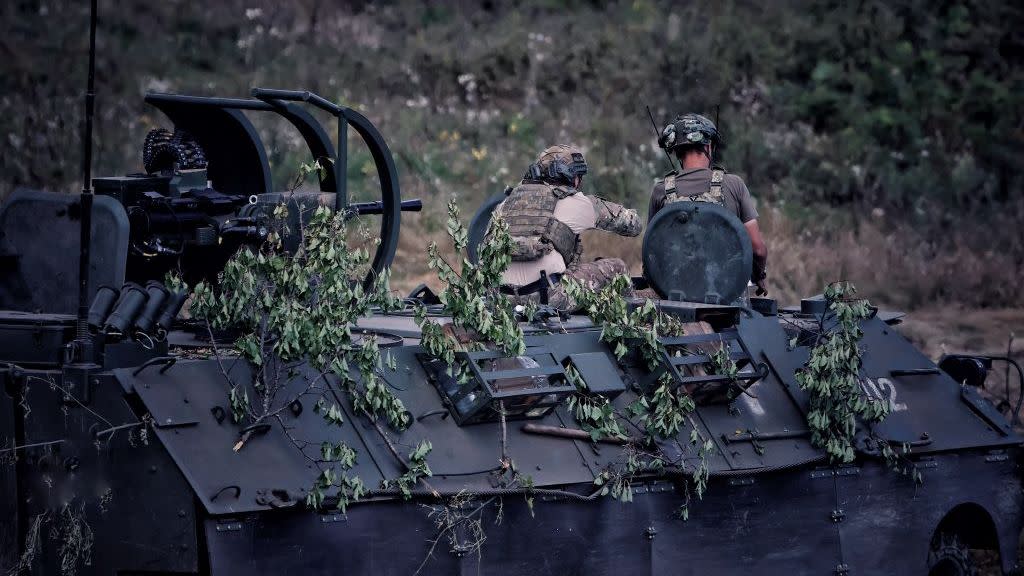Ukrainian Troops Low-Key Hate Their Slapped-Together Armored Vehicles

The annals of armed conflicts are filled with accounts of improvised weapons that end up doing their jobs surprisingly well. But not all such MacGyver-ed projects end up being resounding military success stories.
According to an article by Yan Dobronosov for Ukrainian military media site Militarnyi, such is case for a new and formerly mysterious Ukrainian fighting vehicle. A column of six of these odd vehicles was first spotted in a video posted to Tiktok in June of 2023. Recently, they were revealed to be BMP-1LB ‘fighting vehicles.’
#Ukraine/#Russia 🇺🇦🇷🇺:
I noticed a new version of the 🇺🇦#Ukrainian MT-LBu redesigned for APC.
The vehicles have undergone a complete overhaul, getting additional armour on the sides and rear of the vehicle, new rubber mudguards, baskets for crew stuff, Tucha smoke-grenade… pic.twitter.com/iowiLXKbNF— 𝕻𝖗𝖆𝖎𝖘𝖊 𝕿𝖍𝖊 𝕾𝖙𝖊𝖕𝖍 (@praisethesteph) June 18, 2023
This designation is somewhat deceptive, as this vehicle is not based on the hull of the dated BMP-1 infantry fighting vehicle, nor does it retain anything close to the BMP-1’s heavy cannon and missile armament. The best that can be said for the name is that, like the BMP-1, the BMP-1LB has tracks and is designed to transport troops into combat.
Perhaps more accurately, the BMP-1LB is actually yet another mutation of the MT-LB—a workhorse APC mass-produced to tow artillery and perform various utility functions, but which ended up being adapted to an absurdly wide variety of roles and slap-on weapon systems.
BMP-1LB (modernized MTLB) in service in the Armed Forces 🇺🇦 pic.twitter.com/Ri26Ejhj9S
— MAKS 23 👀🇺🇦 (@Maks_NAFO_FELLA) September 7, 2023
The BMP-1LBs are known to be serving with the 42nd Mechanized Brigade, founded just five months ago. One of the brigade’s three mechanized rifle battalions is already equipped with American-built Stryker APCs, and the unit also uses M1224 MaxxPro MRAP trucks.
📷T-64BV mod.2017 tanks and upgraded MT-LBu APCs of Ukrainian 42nd Mechanized Brigade.#UkraineRussiaWar pic.twitter.com/X4lZxeQH6N
— MilitaryLand.net (@Militarylandnet) September 12, 2023
In theory, BMP-1LBs could introduce a tracked all-terrain mobility option to compliment the brigade’s eight-wheeled Strykers. Unfortunately, the new report suggests that the vehicle’s all-terrain abilities are poorer than one might expect.
One BMP-1LB has already been seen knocked out, apparently having fallen victim of a near-miss from a Russian UMPK glide bomb.
Mutating the MT-LB yet again
The amphibious MT-LB was designed to offer some protection against small arms and shrapnel. It was not, however, built to survive barreling directly into high-intensity combat. But as Ukrainian forces rapidly form new mechanized brigades, there aren’t enough armored vehicles to go around. Only an elite few mechanized infantry units get to ride into battle in powerful Western-supplied Bradley, Marder, and CV9040 fighting vehicles. Many units are instead still rolling into battles in SUVs and up-armored trucks.
The idea of converting readily available MT-LB hulls into more combat-adapted armored personnel carriers—or even heavily armed Infantry Fighting Vehicles—is hardly a new one for either side in the war. Moreover, the MT-LBu are built by Ukraine’s Kharkiv Tractor Factory.
In 2014, Ukrainian firms delivered 62 MT-LB-ATs with elaborate new 12.7-millimeter heavy machine gun mounts. Later, other MT-LBs were fitted with external slat armor and conical 14.5-millimeter BPU-1 gun turrets taken from BTR wheeled APCs. In addition, Ukrainian firm UkrInnMash built an MT-LBu prototype armed with a 30-millimeter Shturm BM3M gun turret called the Kevlar-E.
But following Russia’s large-scale invasion, Ukraine apparently turned to cheaper, faster, and much less refined solutions to meet its desperate wartime need for armored troop carriers. The stretched 17-ton MT-LBu model, for example, is distinguished by the addition of a seventh road wheel, lack of armament and a 25% more powerful engine.

The MT-LBus were sourced from storage (where they were kept under conditions more akin to a ‘landfill,’ according to Dobronosov.) The vehicles were completely disassembled and the components inspected for flaws before they were reassembled and repainted.
Dobronosov doesn’t mince words when describing the “poor quality of work” found on these vehicles. Fresh paint was reportedly applied over old rust, and some BMP-1LBs were delivered with one more track segment than they were designed for, which had to be trimmed away in the field.
Additional panels of spaced armor are welded onto these vehicles to improve their thin 7-millimeter side and rear protection. The rear hull also now sports a bank of 82-millimeter Tucha smoke grenades, which could be discharged to obscure the vehicle from optical- and laser-guided weapons. Other trimmings include new mudguards and side-hull storage bustles.

The new BMP-1LB also gets a big 14.5-millimeter KPV-T heavy machine gun installed in a remote-control weapon station with its own day and thermal night imaging cameras. This arrangement is controlled via a joystick and monitor in the troop compartment by the gunner—a new, third crew member.
This combat module is good for crew survival, as the gunner doesn’t need to be exposed to snipers when firing. Furthermore, the KPV is as an exceptionally hard-hitting machine gun designed to penetrate helicopters and light armored vehicles. It also remains effective out to unusually long range (1.8-2.5 miles), making it more useful for standoff fire support. The passive thermal night sight is also a big advantage over most Soviet APCs.
However, the combat module’s gun shield still leaves the weapon vulnerable to combat damage and environmental fouling. Reportedly, the turrets are unreliable, as the ammunition feed is problematically prone to ingesting dirt and dust that can jam the notoriously sensitive KPV gun.
The passenger’s read door, while not as ideal as the ramp on an M113, is viewed positively, as 7 or 8-person squads in body armor can dismount relatively easily while under fire—unlike the unwieldy side or top hatches in many Soviet wheeled APCs. The same is not true for the driver and commander, however.
Each MT-LBu converted into an BMP-1LB costs 14 million UAH, equivalent to $380,000—half of which is due to the cost of the foreign-imported remote weapon station.
BMP-1LB: Ponderous but affordable
While the BMP-1LB’s shortcomings might seem tolerable, the new combat module and armor add significant weight, even though the MT-LBu’s rear-mounted 300-horsepower YaMZ-238N diesel engine remains the same.
As a result, the BMP-1LB is underpowered. According to Militarnyi, it can manage 31 miles per hour road speeds, but severely slows down on off-road terrain, and allegedly can’t move much faster than infantry on foot in wooded terrain.

Worse, BMP-1LBs reportedly often experience maintenance casualties to their engines or gearboxes after just a few hundred kilometers of driving. Many of the recently delivered vehicles have already required new belts for their cooling systems and replacement track segments.
The BMP-1LB’s slapped-together nature also reportedly results in heavy vibrations while driving. Recall that the UK’s Ajax vehicle had production frozen because it was vibrating so badly that it was causing passengers to grow ill. That said, how severe that problem is for the BMP-1LB is unclear.
Despite these flaws, new production batches of BMP-1LBs continue to be tweaked and improved, with design yet to be finalized. The differences between different iterations will likely result in a maintenance and logistics headache, but will hopefully lead to later production vehicles that perform more reliably in the field.
As Yann notes, “the production of these combat vehicles is a forced decision due to the shortage of normal armored personnel carriers and infantry fighting vehicles in the armed forces.” In other words, Ukraine’s army can—and will—put every piece of moving armor plate between its soldiers and Russian bullets and shells that it can get.
In the end, if the BMP-1LB’s modest armor allows more Ukrainian infantry to survive Russian fire as they roll into frontline positions, it will have achieved its purpose even despite its many shortcomings.
You Might Also Like
